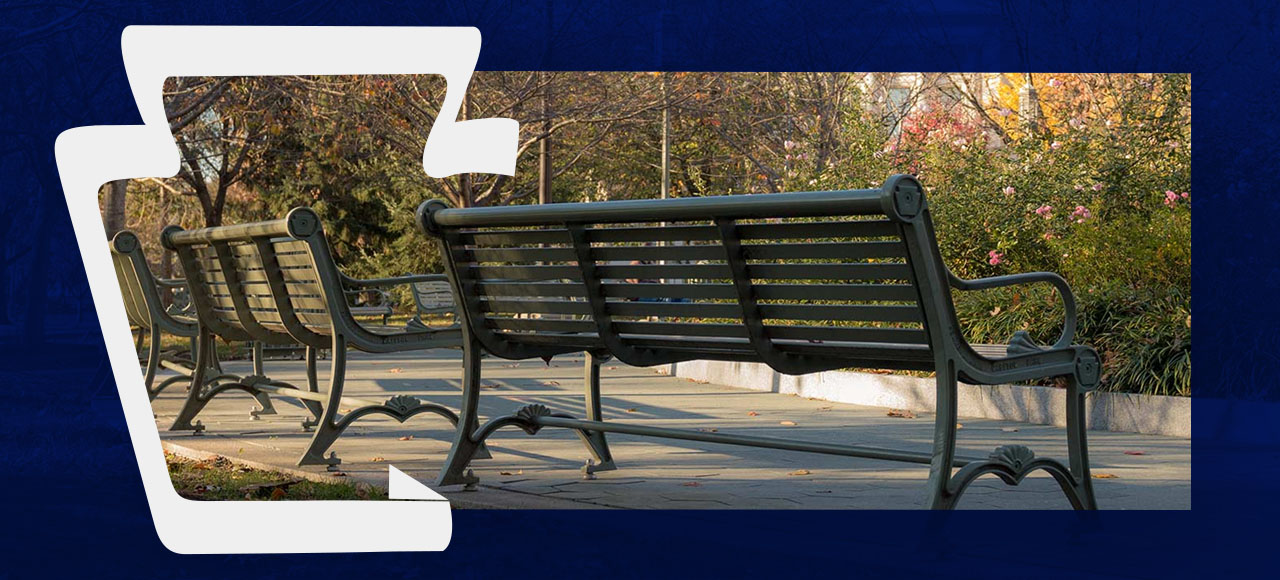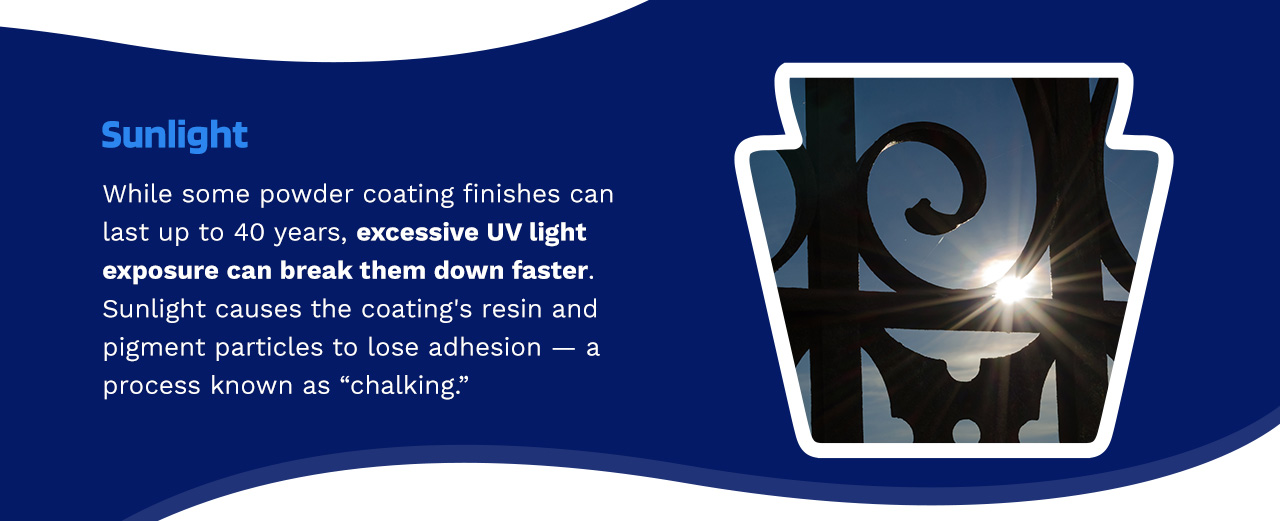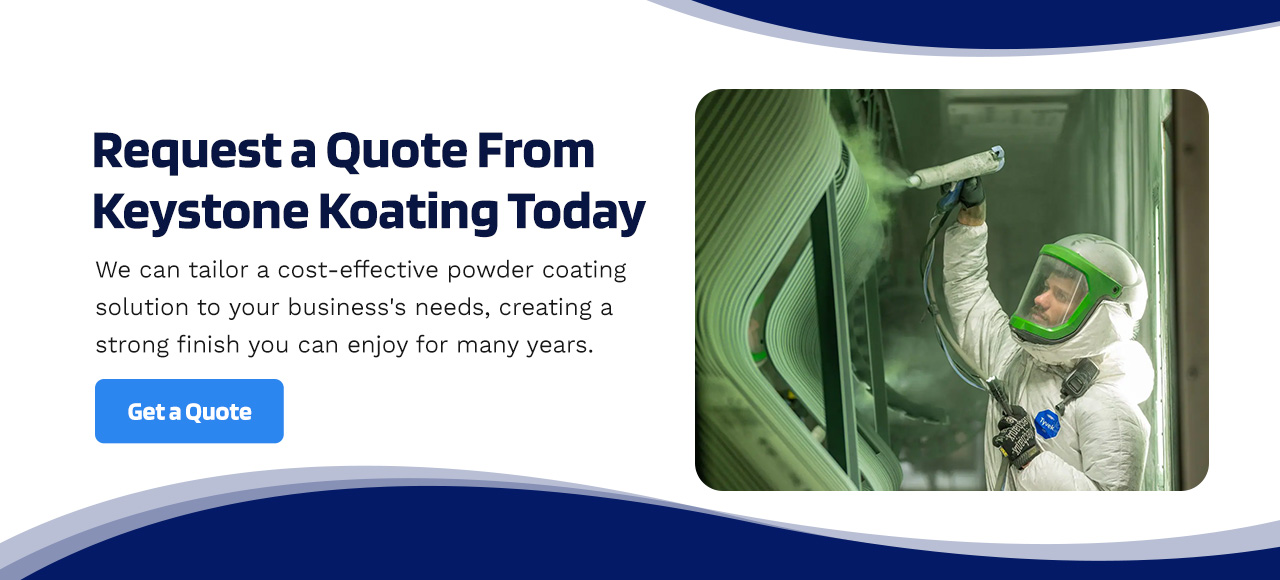
Powder coating is incredibly durable and long-lasting. However, it’s no stranger to the risks associated with weather, humidity, temperature extremes and other external factors. That’s why it’s essential to clean and maintain your powder-coated surface correctly. Doing so can keep it looking pristine, maintain peak performance and tack on a few years to its life span.
You might have a few questions about powder coating maintenance, especially if you haven’t been using it for long. How long does it typically last? Does powder coating last in the sun? What factors can pose risks to the coating, and how do you prevent them from causing premature damage? Continue reading to learn what can damage powder coating and how to manage these risks.
5 Powder Coating Risk Factors
Abrasive cleaning products, weather, ultraviolet (UV) rays and other factors can damage powder coating finishes over time. Once the finish has been compromised, it’s far more susceptible to staining and fading. Below are five variables that can present challenges for powder coatings, along with tips to keep these risks at bay.
1. Salt Water
Powder coating and salt water don’t always get along. Because they’re closer to the ocean, powder-coated gates, fences and outdoor furniture in coastal areas have a higher risk of saltwater damage. Without regular cleaning and maintenance, salt can accumulate on the powder coating and diminish its appearance, giving it a chalky appearance and texture.
Following these cleaning steps can help prevent salt buildup and extend the life span of the fence or gate:
- Remove loose dirt and debris. Wipe the surface gently with a wet sponge or soft brush to remove any loose dirt or grime. Avoid a wire brush, as its harsh nature can damage the finish.
- Remove salt and other deposits. Wipe the surface with a soft brush and mild soap or detergent to remove salt particles. This detergent should be free of petroleum-based chemicals and solvents.
- Rinse and dry. Rinse off the detergent with lukewarm water, then let it dry naturally or with a clean cloth.
You can also clean the fence or gate with a pressure washer. This method is faster than hand-washing, but it can also leave more residue behind. When cleaning a gate or fence in a coastal area, it may be difficult to remove salt buildup with a pressure washer.
Hard water also contains minerals that can harden the surface. That’s why detergent is recommended to soften the water and streamline the cleaning process. If using a pressure washer, use filtered water and keep it on a low setting — a high setting can damage the coating.
Try to clean the powder coating at the beginning of each season. Excessive cleaning is counterproductive and can cause premature wear and erosion, but you also shouldn’t wait a full year to clean the surface. A year’s worth of grime and dirt requires more pressure to remove, which can harm the finish.
2. Sunlight
While some powder coating finishes can last up to 40 years, excessive UV light exposure can break them down faster. Sunlight causes the coating’s resin and pigment particles to lose adhesion — a process known as “chalking.” As the name suggests, this creates a chalk-like layer on the coating surface.
Sunlight exposure typically starts with a faded coating appearance. This is more of a cosmetic issue than a functional one. However, as the resins continue to deteriorate over time, so does the surface’s protection. That’s why proper powder coating maintenance is critical to help it last as long as possible.
Powder-coated surfaces exposed to harsh sunlight — including fences, rails, stairways, outdoor lighting fixtures and furniture — should be properly protected from damaging UV rays. Apply these surfaces with a light coating of high-quality, nonabrasive car wax.
Car wax can provide a protective barrier and extend the finish’s life span. For additional sunlight defense, select a brand with a UV blocker or inhibitor.
Remember to wipe off any remaining wax globs from the surface. Lingering wax can bake into place when exposed to UV light, causing permanent staining. Avoid compound-type waxes, as their abrasives can damage the powder coating.
3. Cleaning Products
Harsh chemical cleaners and solvents can corrode powder-coated surfaces, make them more vulnerable to staining and fading, and reduce their life span. Stick with gentle cleaning agents when caring for your powder coating. Water and mild soap will usually suffice for most dirt and grime.
Remember to use the right cleaning tools as well. Steel wool, scouring pads and wire brushes can harm the surface. Instead, think of tools you would use when washing a car, such as soft brushes and sponges. If you need to use a solvent-based cleaner for a difficult area, start with the weakest cleaner and try a test spot first.
When using detergent to clean a powder-coated surface, determine whether the product is safe for your hands. If you need to wear protective gloves when using this product, chances are it isn’t safe for the powder coating, either.
4. Weather and Temperature
Temperature extremes can also compromise powder-coated surfaces. For most metal objects with powder coatings, 68 to 80 degrees Fahrenheit is a suitable temperature range. However, fluctuations between winter and summer months make it a challenge to achieve an ideal temperature.
Store metal objects indoors during these seasons or when they aren’t in use — especially if they’re unsuitable for external applications. This can help your powder coating maintain its look and performance longer.
There are also high-temperature coatings specifically designed for items like grills, generators and automotive parts that can’t go indoors. Additionally, some powder coatings have reduced impact resistance for extremely cold temperatures.
5. Humidity
Over time, humidity can corrode metal objects and powder coating finishes. High humidity levels can diminish the coating’s durability and appearance.
It’s important to exercise caution in particularly humid areas. Moisture can interfere with the adhesion process, and powder coatings can absorb and trap moisture before curing is complete. Discoloration and staining can occur as a result.
To prevent condensation and corrosion risk, the Powder Coating Institute (PCI) recommends keeping metal parts with cured surface coatings at a 50% to 60% humidity range, even while in storage. For interior powder coatings, a humidifier can ensure proper humidity levels and prevent premature finish damage.
Request a Quote From Keystone Koating Today
At Keystone Koating in Pennsylvania, we provide high-quality powder coating services for a variety of industries, including industrial, agriculture, architecture and more. Our team is proud to offer the following benefits for our clients:
- Over 30 years of powder coating expertise
- Personalized services and care
- Fast turnaround times
- A variety of colors and textures
- Various industry certifications and verifications
- Numerous materials, including aluminum, iron, steel and zinc alloy
We can tailor a cost-effective powder coating solution to your business’s needs, creating a strong finish you can enjoy for many years. Get a quote for our powder coating services today!



